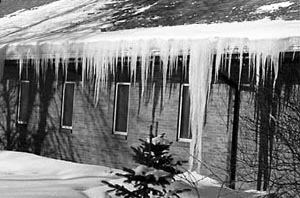Ice Dam Removal & Prevention Minneapolis MN
Winters are brutal for the Twin Cities with days on end of subzero temperatures and horrendous wind chills. Unfortunately for my fellow Minnesotans, the cold this year could be especially awful. A very cold and snowy winter is in store for the Midwest. It looks like 2012-13 could be a year for the Midwest to get hit by heavy snow and ice storms, which can leave large amounts of snow and ice on roofs. Minnesota homeowners should brace themselves for the possible return of bothersome ice dams.
Ice dams are created by a number of different factors, such as snow accumulations and heat loss.
In most cases, ice dams begin inside the house, when heated air leaks up into the unheated attic. In the winter, the roof above the unheated attic is cold. When warm air leaks into the unheated attic, it creates warm areas on the roof which in turn cause the snow on the exterior of the roof to melt. The melting snow moves down the roof slope until it reaches the cold overhang, where it refreezes. The process continues, causing ice to build up along the eaves and bingo—you have a full-fledged ice dam.
Eventually this dam forces the water to back up under the shingles and sometimes into the ceiling or wall inside the home. In addition to roof and water damage, ice dams may cause structural framing members to decay, metal fasteners to corrode, and mold and mildew to form in attics and on wall surfaces. The good news is the damage is completely preventable!
Attic Air Leaks = Ice Dams
The Solution – Sealing Attic Bypasses
The pathways through which heated indoor air moves into the attic are called attic bypasses. To prevent ice dams, attic bypasses must be eliminated. Ideally, attic bypasses are eliminated – or prevented – when the home or building is constructed, since some attic bypasses are not always accessible after construction.
The Minnesota Energy Code requires sealing the following areas to prevent air leaks:
- Penetrations in the building envelope for electrical and telecommunication equipment
- Electrical boxes and fan housings (such as exhaust fans)
- All exterior joints that may be a source of air intrusion
- Rim joists
- Lighting fixtures, including recessed lights and wire penetrations
- All plumbing and heating penetrations (including chimneys, flue pipes, and ducting)
- Attic hatches
Other common sources of attic bypasses are:
- Balloon framed walls and walls that span both heated and unheated spaces, such as in split level houses
- Kneewall construction in story-and-a-half houses
- Dropped ceilings over bathtubs, closets and cabinets, and kitchen soffits
- Other areas where walls are not completely sealed at the attic such as stairway walls and interior partition walls
Complex roof construction can increase the risk of ice accumulation, such as a roof with different surface angles that vary in their exposure to sunlight and drain into valleys such as condominiums and townhouses.
Ice should be removed by steam. It is the most safe and efficient way to remove ice dams and not cause serious damage to your roof. Anything else is a waste of time.
Here is the deal. We are professionals and have fixed hundreds of roofs that have been damaged by well-intentioned folks with hammers, picks and hatchets in their pursuit of removing ice dams. We strongly advise against the hack approach.
If you have snow that needs to be removed or have ice icicles hanging off your roof, contact a Minnesota Ice Dam and Snow Removal Company that specializes in Ice Dam Removal and Roof Snow Removal.






